William M. Arkin
Palestinian civilian casualties have become the issue in the Hamas War, precipitating worldwide condemnation of Israel. "A staggering and unacceptable number of civilian casualties," United Nations Secretary-General António Guterres has said. "Far too many" Palestinians have been killed, said Secretary of State Antony Blinken. President Joe Biden summed up the dilemma Tuesday, saying that while Israel has had European support in addition to U.S. backing, "they're starting to lose the support by indiscriminate bombing that takes place."
The high number of Palestinian deaths has provoked accusations of Israeli war crimes and even genocide, on the premise that civilians are being intentionally targeted. Government officials from around the world and media outlets have sustained the impression that Israel is attacking hospitals, schools, refugee camps and humanitarian facilities, all seemingly with a disregard for civilian life. If Israel were attacking indiscriminately or targeting civilians—it's not—that would indeed constitute a war crime.
Calculating the acceptability of taking any human life creates the weightiest of moral dilemmas, and the images of suffering in Gaza have prompted demands by many for a ceasefire. But armies must always weigh the cost of civilian lives against any perceived military advantage according to the laws of war.
To try to answer the question of whether so many civilian deaths and injuries are indeed too many—according to legal definitions of proportionality—Newsweek spoke to over a dozen active and retired Israeli Defense Force (IDF) and U.S. military and intelligence officers, all of whom were able to speak more candidly because they were granted anonymity, often in criticizing the conduct of the war. Newsweek also spoke to a number of prominent human rights experts and has reviewed Israeli and American classified data relating to the conflict.
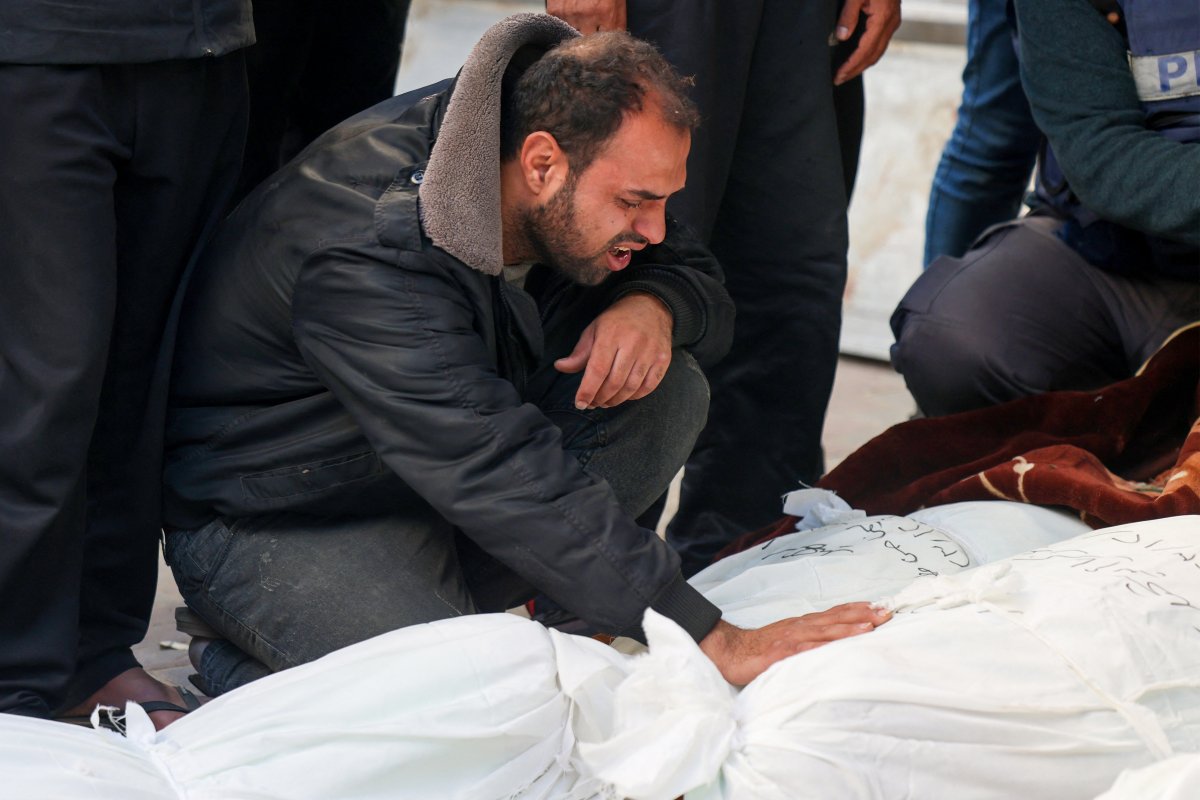
How many Palestinian deaths are too many? A man mourns victims killed during Israeli bombardment overnight at al-Najjar hospital in Rafah on the southern Gaza Strip on December 7, 2023.SAID
The casualty numbers that are emerging from Gaza are startling; the images from Gaza, heartbreaking. But based on new and exclusive data about the magnitude of Israel's attacks, the number of Palestinian casualties, while high, does not appear to be disproportionate by the kind of measures used in international law: not in terms of the number of weapons used by Israel, the number of targets hit, the nature of Hamas or the unique features of the Gaza Strip, with its exceptionally high population density. U.S. military sources, many of whom are critical of much of Israel's conduct, agree.
Israel is focused on conduct—each individual strike and its compliance with the requirements of international law—while Washington is focused on results, which means the state of Gaza overall as a result of strikes. It is a philosophical disagreement that helps explain the nature of Israel's attacks and the ferocity of the public debate.
"Part of the problem in the end is Israel's arrogance," says a U.S. Air Force officer who has been involved in internal deliberations within the Biden administration and discussions with his Israeli counterparts. "Even to us, in private and candid conversations, they have referred to the Hamas surprise attack and its brutality, they have invoked the Holocaust, they have blamed Hamas, they have referred to 9/11 and argued the 'Never Again' justification for their unforgiving operation. The simple truth is Israel has lost the information war because it has destroyed so much, even if they can justify each individual attack."
Israel's assault on Hamas is one of the most intense in recent times, taking place in an area of 141 square miles (365 sq. km.), roughly twice the size of the city of Washington DC and home to roughly 2.3 million people. According to information never before published, Israel has attacked some 25,000 targets in Gaza, from the air, ground, and sea, delivering some 140,000 weapons, 60 percent of them artillery rounds and 40 percent weapons dropped from aircraft.
Hamas-controlled government authorities in Gaza say that at least 24,500 civilians have been killed, including those missing under the rubble, a number that the international humanitarian community accepts as valid. According to Palestinian authorities, some 10,000 buildings have been destroyed, including high-rise apartments, with almost ten times as many damaged. Israel says that it has identified more than 800 tunnel entrances in the 300-mile-long underground system, destroying more than half of them. Israel claims to have killed more than 6,000 Hamas fighters. Another 1,000 have been captured.
"Israel has been precise in its bombing and has caused enormous civilian damage," says a senior U.S. military intelligence officer who is involved in analysis of the war, commenting on how difficult it is the reach a definitive judgment.
"It is hard to believe that such widespread destruction was necessary to address the threat from Hamas," says Ken Roth, former director of Human Rights Watch and now a visiting professor at Princeton University, reflecting a view shared by many in the U.S. government, that Israel could have—and should have—pursued different strategies to eliminate Hamas.
According to international law, proportionality requires armed forces to refrain from attacks that would inflict incidental civilian harm "excessive in relation to the concrete and direct military advantage anticipated to be gained." Attacking forces must take "feasible" precautions to reduce the risk to civilians. As the Pentagon says in its own manuals, "Proportionality and precautions are intensely fact-bound. Civilian harm, military advantage, and feasibility are difficult to quantify. Their application often depends on the circumstances on the ground, at a fleeting moment, during the chaos of war."
Ben Saul, the Australian incoming UN Special Rapporteur on the Promotion and Protection of Human Rights and Fundamental Freedoms while Countering Terrorism, explains the challenge of assessing proportionality. "International humanitarian law does tolerate killing some civilians, where they are incidental casualties of a lawful strike on a military target. But it is difficult to know without having more information from inside that targeting process, about whether Israeli forces were exceeding the rules that they must respect when they make those targeting decisions."
Israel declined official comment to Newsweek on the issues raised in this investigation. An IDF Air Force officer who agreed to speak off the record says the number of civilian deaths is "minimal" given the nature of the conflict. "On October 7, Hamas attacked southern Israel and killed 1,200 people in a matter of hours. This is what the intentional killing of civilians looks like. We've done nothing of the sort," the officer said.
The nature of war is that it takes place with limited and unreliable information ("the fog of war") and the Hamas war is no different. We know little about the details of Israel's military campaign, from what types of weapons have been used to precisely which specific targets were struck and why.
There may be no definitive answer to the military and strategic question of what constitutes an acceptable number of civilian casualties, but the story of Israel's anti-Hamas campaign helps explain why all sides may be right in their analysis. Outside organizations, including Iraq Body Count, Armed Conflict Location & Event Data Project (ACLED), and Airwars, have endeavored to evaluate civilian deaths in Gaza by comparing the number with other recent conflicts from Syria to Ukraine. There are various calculations of the ratio of those killed to those wounded. Some of these studies examine the distribution of genders and ages compared to other conflicts. Others look at the destruction of housing, buildings and other objects; or they argue that Israel's blockade of Gaza and the lack of food, water, electricity and fuel supplies has led to an elevated level of excess death. Some decry the number of UN workers or journalists killed. All these evaluations conclude that the Hamas war is unprecedented. But they do not answer the question, how many is too many?
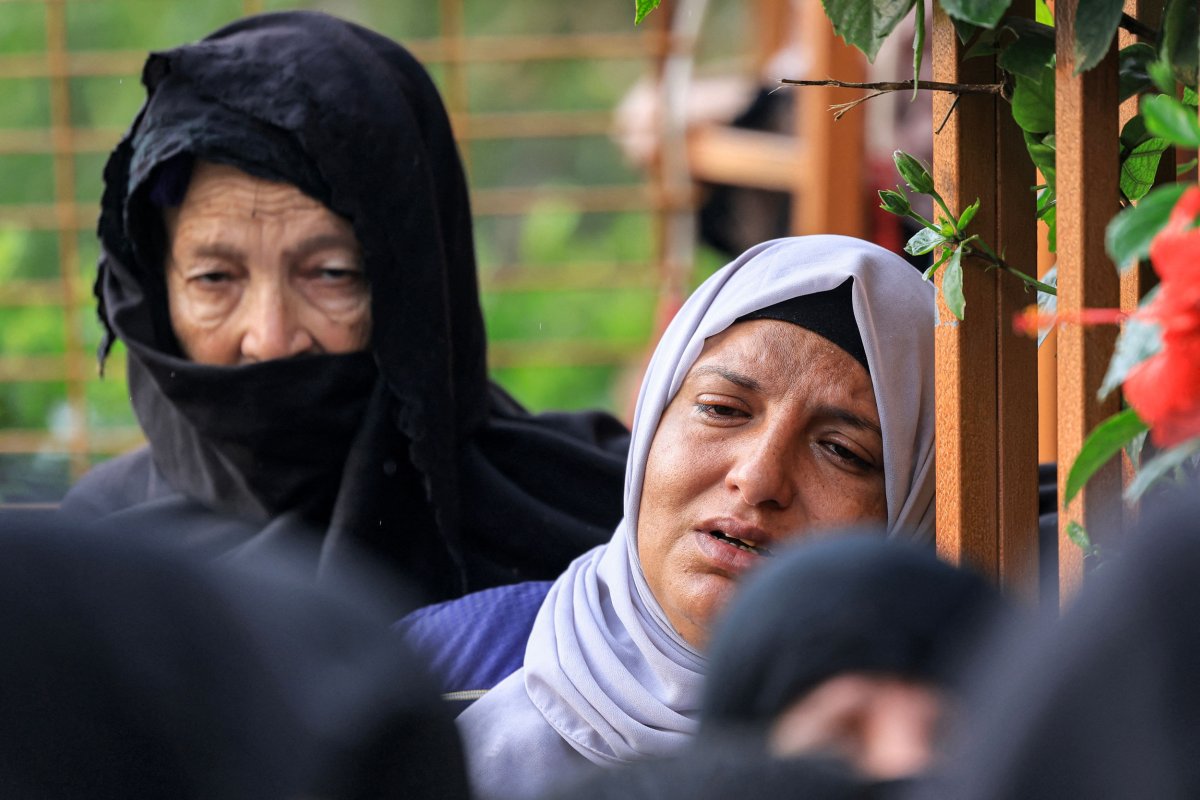
Mourners outside the morgue at Nasser hospital in Khan Yunis in the southern Gaza Strip on November 14, 2023.
Israel has questioned the veracity of the Palestinian numbers, arguing that it includes Hamas fighters. Alternately, Israel argues that civilian deaths are the fault of Hamas because it hides behind civilians or under schools and hospitals, or that Hamas itself has caused many of the deaths with its own weapons. The IDF says that it has done more than any military in history to minimize civilian harm.
The IDF declined to engage with Newsweek, replying "no comment" to a series of specific questions regarding weapons, targets and conduct of the war. However, a number of IDF officers, serving and retired, were willing to engage if their identities were not given. Newsweek has granted these requests because the subject matter is so important.
"We have taken much criticism, especially in the United States, so much so that the news media just assumes that things hit or damaged were intentionally targeted," says a second senior Israel Air Force commander. "In that way, the narrative builds that a hospital was a target, or a school, when in fact, the target is always Hamas. Even Prime Minister [Benjamin] Netanyahu says that it is regrettable that despite our best efforts we have not minimized civilian harm. But have we targeted civilians or tried to kill them? Absolutely not."
"Israel is not targeting civilians or civilian objects," agrees the senior U.S. Air Force officer who has been involved in analysis of the war and has taken part in internal discussions. "Not because they are civilian per se. Are they attacking Hamas in places that we might not be willing in our own wars? Yes. Are they willing to absorb more criticism [than us] in pursuit of their military aims? Yes. But there is no absolute with regard to minimizing civilian harm, merely that efforts be made. They have done that."
Another retired U.S. military officer, now a senior civilian in the intelligence community explains: "The IDF has a different culture than exists in the U.S. or in NATO, and it fights with a different ferocity. Just because the numbers might be higher than what we are used to seeing does not mean they are excessive. The conditions here are unique."
The 'Maximum' Response on the First Night
On the first night of Israel's retaliation, fighter planes, attack helicopters and ground and naval artillery struck over 500 targets inside Gaza, including what the Israeli air force described as "multi-story buildings" that were identified as the offices and residences of Hamas and Palestinian Islamic Jihad officials and commanders. The IDF was implementing an existing contingency plan, officials say, one that represented the "maximum" response to a major attack, hitting identified military bases and underground facilities, and especially focused on the offices and residences of Hamas leadership. Hamas launching points for rockets and mortars were also hit, as were observation and sniper posts for a total of approximately 1,200 targets.
According to U.S. intelligence, the Israeli air force dropped approximately 2,000 bombs totaling over 1,000 tons of explosives in the 72 hours covered by the existing plan. According to the IDF spokesman, 21 high-rise buildings were attacked. After the initial operations, the Palestinian Ministry of Health said that 849 civilians had been killed and 4,250 had been injured.

Members of the Israeli Defense Forces at a staging area near the border of Gaza on December 11, 2023, outside of Sderot, Israel.
With the declaration of war, Israel military officials directed changes in targeting emphasis and relaxed some existing rules of engagement given the scope and damage of the Hamas attack, according to both U.S. and Israel military sources. IDF spokesperson Rear Adm. Daniel Hagari publicly declared that "the emphasis is on damage and not on accuracy."
A current serving senior IDF officer who spoke to Newsweek explains: "The real change was that we shifted from a limited punishment campaign to the mission of eliminating Hamas. That meant going from hitting a few targets here and there to a massive effort to destroy the Hamas military machine. It is just not comparable to other confrontations."
Israeli Minister of Defense Yoav Gallant toured the Gaza front at the end of 72 hours, labeling the Hamas war a "full-scale response" for which he had "removed every restriction" on bombing. "We act precisely and professionally but not surgically," said Israel's Air Force Chief of Staff Brig. Gen. Omer Tishler. "I'm not talking about single, tens, or hundreds [of weapons]. We are talking about thousands of munitions," he said. In past battles, he said, the Israeli air force might target one or two objects at a time, whereas in the current "Swords of Iron" campaign, it was targeting combinations of many targets, known in the U.S. as target networks. "We have no constraints on energy or resources," Tishler said. "Our relentless machine will continue to operate, strike, and dismantle, all aimed at reshaping the situation from the very foundation."
With the completion of the prepared plan, Israel expanded the scope of its attacks, much of the new targeting based on Hamas movements and continuing additional attacks on Israel. The IDF and U.S. intelligence estimated that the Hamas military wing, the Izz ad-Din al-Qassam Brigades, had just over 25,000 fighters organized in 24 battalion groupings made up of 140 combat companies, including infantry, rocket artillery, anti-tank, air defense and engineering units. In addition, the IDF says that Palestinian Islamic Jihad had another 17,000 fighters for a combined total of some 42,000.
For each element, the IDF identified fixed headquarters and support facilities. As the units and fighters scattered, they then became targets. Northern Gaza, where the initial bombing concentrated, was home to two of five Hamas brigades, the Gaza City brigade, the largest with about 9,000 fighters; and the North Gaza brigade, with about 4,800 fighters, according to U.S. intelligence.
Tishler and other IDF officials said that in the first week of the war, pilots left their airbases either with designated fixed targets, or in the case of mobile or dynamic targets, were passed the coordinates of specific targets while the aircraft was in the air. IDF officers who spoke to Newsweek say that particularly in the early days, the emphasis was indeed on damage to the Hamas military machine, even if it was in or adjacent to civilian structures and activities.
IDF and U.S. military sources say virtually all weapons used by Israel in this initial phase were precision-guided, from bombs to artillery projectiles and rockets: a routine Israel followed to be able to hit targets in the dense urban environment while minimizing damage to adjacent structures. According to the IDF, Israel also declined to use certain weapons—such as cluster bombs or white phosphorus—despite not being signatory of any of the conventions that ban their use under some circumstances.
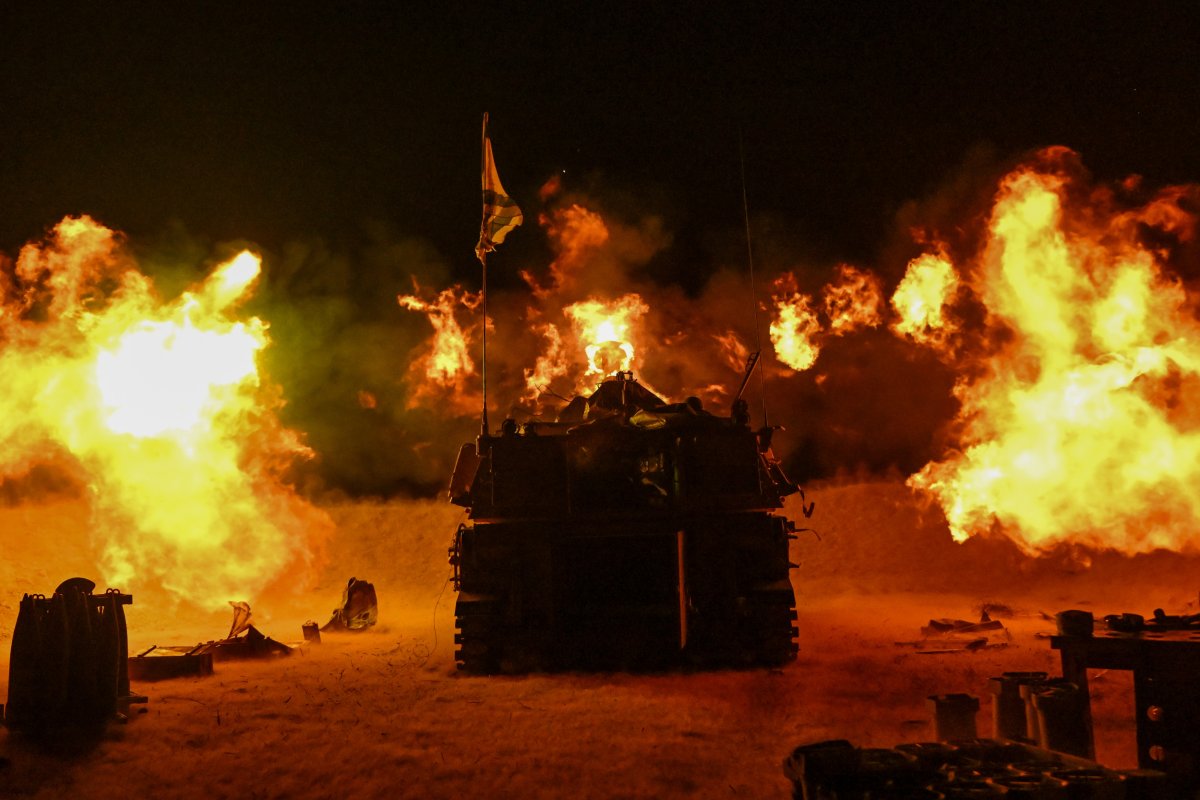
An Israel Defense Forces artillery unit, using a self-propelled howitzer, fires toward Gaza near the border on December 11, 2023 in southern Israel.
Still, 1,200 targets throughout Gaza dwarfed any previous operations, especially in such a populated and concentrated area. As the international outcry grew, the Biden administration began internal discussions about the nature of the Israeli retaliation. The U.S. Air Force officer involved in those discussions tells Newsweek that not only were the Israelis bombing more broadly than American practice, Israeli forces used a preponderance of larger bombs than the U.S. might (at least in the first two weeks). The U.S. Air Force and the Defense Intelligence Agency reported that Israel was hitting many fixed targets that it assessed had already been evacuated by fighters, choosing to destroy the physical infrastructure to make it unusable by Hamas later, a practice eschewed by the United States in its recent wars because such attacks could be interpreted as unlawful.
"I'm not saying that Israel is ho-hum about the incidental impact" to civilians in its bombing, a second Air Force officer told Newsweek, "but they are pretty ho-hum, that is, they are willing to kill civilians in their singular pursuit" of the destruction of Hamas, given the parameters of their mission. It's not the way the United States generally fights, the officer says, "but we've never faced a close-in enemy of this sort hiding amongst civilians. Even in Kabul and Baghdad, we were mostly fortunate to have distinct military infrastructure to target, especially in Baghdad. Because of Hamas, the military infrastructure in Gaza is Gaza."
At the end of the first week, Israel called for residents of Gaza City to evacuate their homes and move "southwards for their own safety and protection." By then, Israel had struck 2,687 targets, according to IDF data. About half of the targets struck were headquarters, offices, command and control headquarters, and leadership locations. According to the Ministry of Health in Gaza, a total of 1,417 civilians had been killed and 6,268 injured by the end of the first week. Israel felt that it was successfully minimizing civilian harm, sources tell Newsweek.
"Don't these numbers show how few civilians were dying?" asks a retired IDF general when presented with the data. "We supposedly were demolishing whole neighborhoods and striking high-rise apartments and yet fewer than one civilian was killed per target on average?"
With supplies of electricity, fuel and water cut off or diminishing, and given the intensity of Israeli bombing, concerns about the plight of Palestinian civilians mounted. "Crucial life-saving supplies, including fuel, food and water, must be allowed into Gaza," UN Secretary-General Guterres said. President Biden urged Prime Minister Netanyahu to "minimize civilian casualties" in their first phone call, but according to U.S. officials his concern was related to Israel's adoption of a full-scale warfare strategy more than it was based on any conclusion on the part of U.S. intelligence that indicated a disproportionate number of civilian casualties.
As public pressure and disapproval mounted, Israel tried to explain its bombing. "It cannot be concluded from the mere fact that seeming 'civilians' or 'civilian objects' have been targeted, that an attack was unlawful," the IDF said in a legal White Paper. "The military advantages that the IDF is seeking include destroying enemy military assets, targeting militants, degrading and denying enemy ability to command and control operations, neutralizing underground tunnels and infrastructure used for military purposes, and denying positions (such as sniper, anti-tank and surveillance posts) which endanger IDF ground forces ...."
The internationally recognized Law of Armed Conflict, the IDF said, demanded that Israel undertake a proportionality assessment at the time of the attack, not in hindsight based on how many civilians were killed or claimed killed. The IDF, it said, closely examined every individual target, applying "restrictive measures" in any attacks on hospitals, schools, places of worship or UN facilities. "Civilian casualties or damage to civilian objects, while tragic, do not of themselves allow for a conclusion in regard to proportionality without an informed assessment of both the expected civilian harm and the military advantage anticipated at the time of the attack," the IDF said.

A Palestinian man carries an injured child in a makeshift morgue near the bodies of Palestinians killed in Israeli bombardment, at the Shuhada Al-Aqsa hospital, in Deir el-Balah, in the central Gaza Strip on November 6, 2023.
And yet a legal white paper could not compete with the images out of Gaza that showed entire neighborhoods reduced to rubble, and the bloodied and broken bodies of dead children. In internal discussions in Washington, Secretary of Defense Lloyd Austin and other high-ranking military officials questioned Israel's justification for attacking certain targets, particularly high-rise apartment buildings, and conveyed as much to their IDF counterparts.
"The IDF was prepared to justify each individual strike in terms of proportionality, but we definitely felt like this was Israel's own shock-and-awe, that the purpose was not only to destroy what the IDF considered militarily vital targets but also to pressure the civilian population and even to raise morale inside Israel," the Air Force officer who was involved in those discussions tells Newsweek.
Proportionality isn't some "exact science" the officer says. "I'm not a lawyer, but my understanding is that the measure of proportionality relates to military necessity at the time of the strike and not to the number of civilians killed. An attack that kills no civilians can also be disproportionate for the sheer civilian damage it causes."
At the end of 10 days of bombing, Israel said it had attacked around 5,000 targets in Gaza. Visiting an Israeli base, Defense Minister Gallant repeated Israel's goal: "We will wipe out the Hamas organization and dismantle it of all its capabilities." It was another bold statement, though multiple U.S. intelligence sources tell Newsweek that only about 1,400 Hamas combat casualties were estimated at that time from the attacks. They raised questions about the military tactic behind the attacks and suggested that the IDF's intent was indeed to punish the Palestinian people, U.S. officers tell Newsweek. "It's hard to come to any other conclusion," says the senior defense intelligence officer.
Fallout From a False Report
Everything changed that evening. At 6:59 p.m. on October 17, the parking lot of al-Ahli Arab Hospital in Gaza City was hit. Palestinian authorities claimed that 471 civilians were killed in an attack by Israel. The number was widely reported in the news media. The strike was soon shown to be the result of an errant Palestinian Islamic Jihad rocket; U.S. intelligence now believes, according to military sources, that fewer than three dozen civilians were killed. Yet even though media outlets apologized for the error, the narrative that stuck was that Israel was responsible for a particularly cruel and deadly attack. President Biden arrived in Israel for the first visit by a U.S. president during wartime to find meetings canceled by Egyptian, Jordanian and West Bank leaders over the supposed hospital strike. UN Secretary-General Guterres called for "an immediate humanitarian ceasefire."
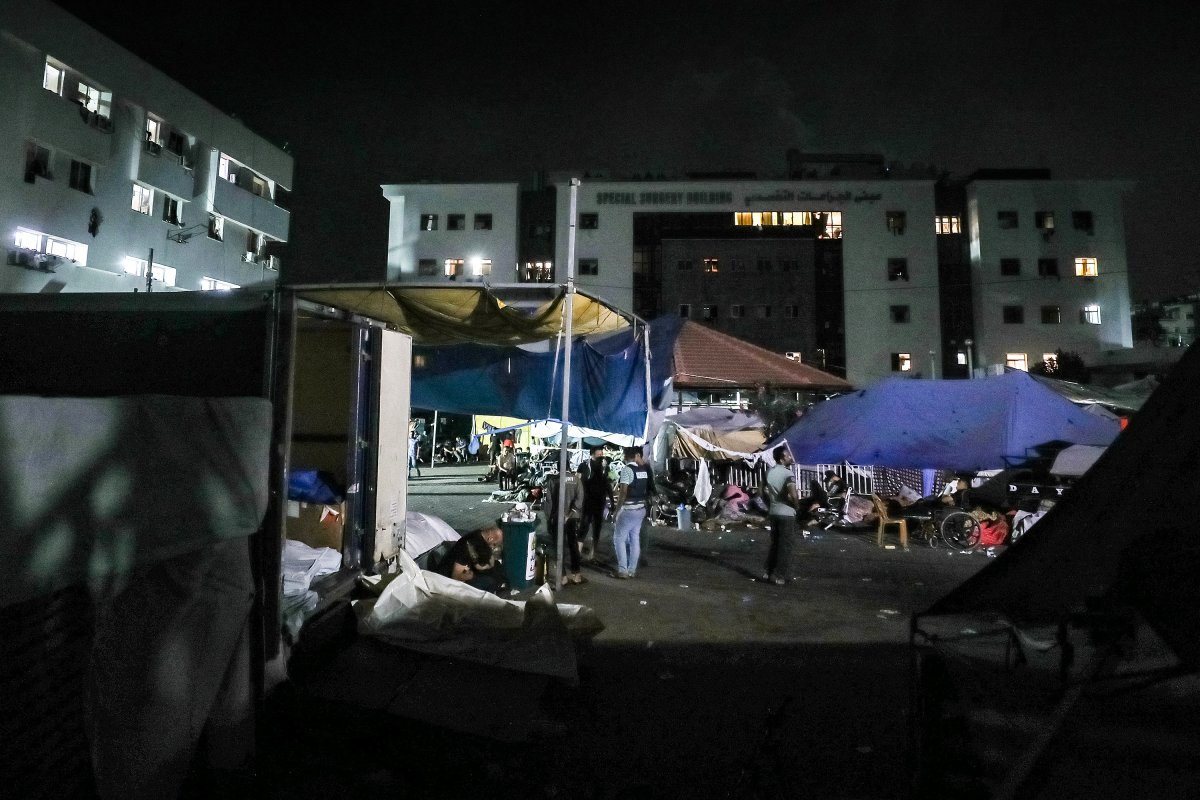
After the explosion at Al-Shifa hospital, Gazans wait in tent shelters in the darkness as fuel for electricity generation runs out, in Gaza City early on November 3, 2023.
While Washington was telling the Israelis to do "everything" that could be done to minimize the loss of civilian life, U.S. intelligence observers say that there were few specific disagreements over individual targets. The Biden administration was more concerned about the "tone" of the campaign, multiple officials say. "The administration supports the overall war goal—eradicate Hamas—but it was uncomfortable with how Israel is pursuing that goal," says the Air Force officer involved in the internal discussions. When asked if perhaps, given how much it is bombing, Israel indeed was minimizing civilian deaths, the officer says there are few precedents to substantiate "too many or too few."
"We're in uncharted territory," the officer says.
"It is the very level of effort that made U.S. leaders uncomfortable," says a retired military lawyer who has been involved in target review for four different American campaigns. "Even when the U.S. was attacking the Taliban and al Qaeda in Afghanistan, or Saddam Hussein and his cronies in Iraq, there was a presumption of minimum force, and a prominent level of concern about public opinion regarding civilian casualties. That is American military culture dominated by what Washington is concerned about—not necessarily military necessity in the strictest sense. Israel is different as are the conditions on the ground in Gaza. Most important, the military and the leadership live in the same place and experience the same emotions regarding threats and vulnerability. They are fighting for their very survival. Still, to say that Israel threw out the rulebook and indiscriminately bombed civilians is absurd."
As Israel prepared to shift to ground operations at the end of October, it accelerated the pace of its bombing. "We dealt the enemy the hardest blow he has suffered in a single day," Netanyahu said on October 23, referring to airstrikes against some 400 targets in the previous 24 hours. In one day alone, Israel struck 150 suspected tunnel entrances and underground targets, many of them located under civilian structures.
"Let me just make it crystal clear: the number of appropriate civilian causalities in this or any other conflict is zero," National Security Council spokesman retired Rear Adm. John Kirby said at the time. It is an "extremely unfortunate byproduct of this campaign that there are civilians that are unfortunately harmed and civilians that are killed."
"I hesitate to criticize our American friends, but the appropriate number of civilian casualties is not zero. It is the number required by military necessity after all due precautions are followed," says a retired IDF lawyer who has been involved in target review going back as far as the 2006 Israel-Hezbollah war. "I think Mr. Kirby misspoke."
"The death toll is rising rapidly," the Associated Press reported as the ground fighting commenced on October 26. The Gaza Ministry of Health reported a total of 704 Palestinians killed in 24 hours, the highest daily toll since October 7. IDF officials rejected the claim in part because health authorities had no access to the areas where the Israeli army was operating.
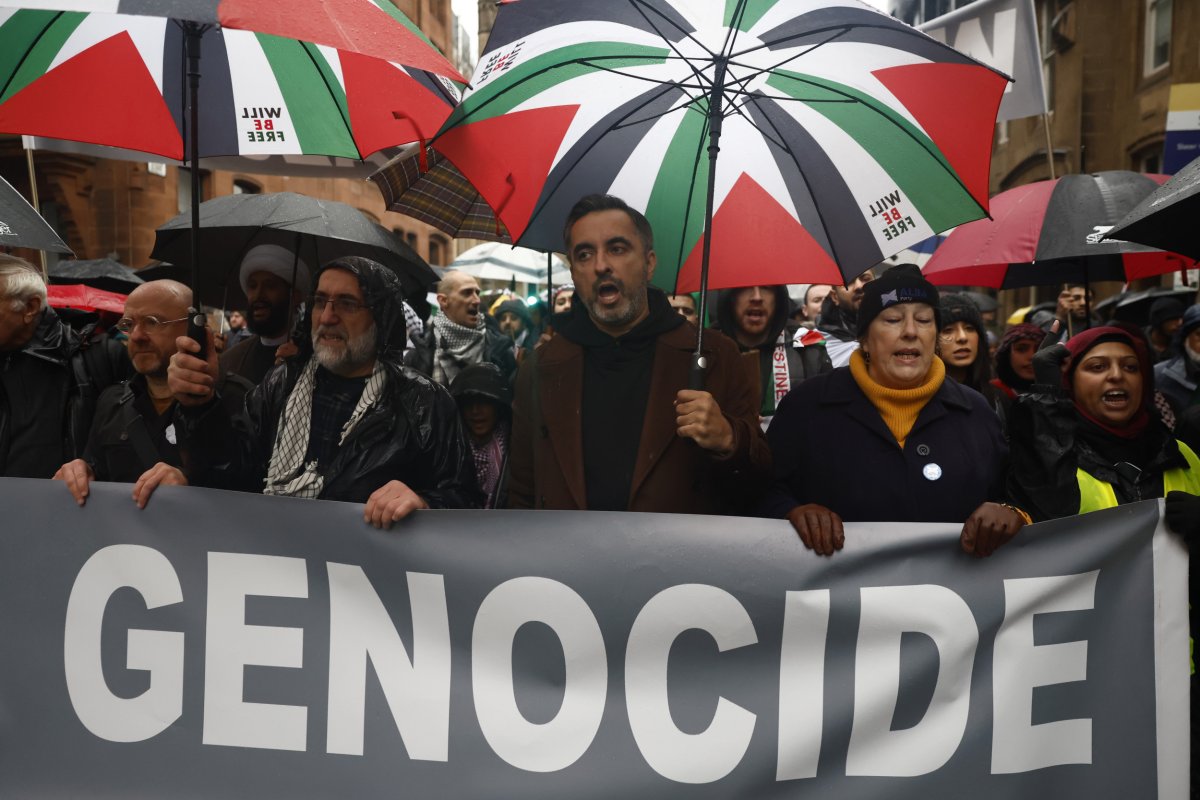
The IDF campaign prompted accusations of "collective punishment" and genocide. Here, protesters in Glasgow, Scotland, demand a ceasefire in the Israel-Hamas war on November 18, 2023.
Fighting its way into Gaza territory, the IDF found itself facing widespread condemnation of its "collective punishment" of the Gazan population. In response, Israel cited the warnings it provided to Gazans living in the north to move south, and to the fact that Israel also dropped leaflets, posted warnings on social media, made phone calls, and sent texts and targeted emails to Palestinians warning them of general and specific strikes to come. On November 5, the Israeli government declared that it "has done more than any army in the history of warfare to protect [the] other side's civilians."
Israeli officials vigorously questioned the number of Palestinian civilian deaths and the U.S. appeared to agree. "I have no notion that the Palestinians are telling the truth about how many people are killed," President Biden told PBS NewsHour on October 25. "I'm sure innocents have been killed and it is the price of waging war," he added. The White House will not use "numbers put out by an organization that's run by a terrorist organization," Kirby said the next day.
Internally though, the U.S. intelligence community agreed that the number of Palestinian civilian deaths was consistent with Ministry of Health claims, according to multiple sources. "Given the magnitude of Israeli bombing, the intertwining of military and civilian, and the population density, the numbers aren't shocking," says the U.S. Air Force officer involved in the deliberations.
Washington Has Three Questions for Israel
According to multiple U.S. and Israeli sources, Washington presented Israel with three substantive points regarding its conduct of the war. First, it questioned the necessity of bombing civilian infrastructure (such as Hamas residences) to achieve the long-term gain of denying Hamas an operating base. Second, it questioned Israel's use of 2,000 lb. bombs and the ferocity of its initial bombing in the north, arguing that weapons with less explosive yield might produce fewer casualties. And third, the U.S. questioned Israel's goal of eradicating Hamas, from which so many of its target justifications flowed. Not only did U.S. officials think the goal was impossible to achieve, they also feared the repercussions for Israel of pursuing such an objective: that the stain of indiscriminate bombing and a widespread belief that Israel was intentionally killing civilians would undermine Israel's security even if it won the battle.

Israel is "starting to lose the support by indiscriminate bombing that takes place," President Joe Biden warned on December 12, 2023. He met with Israeli Prime Minister Benjamin Netanyahu in Tel Aviv on October 18, 2023.
Israel conceded to the Americans about the use of 2,000 lb. bombs, IDF sources told Newsweek. The modification was made as the independent air campaign largely ended and the IDF shifted its emphasis to attacks to "dynamic" targets, where drone intelligence or a soldier on the ground sighted a Hamas target and called in a strike.
"If the United States was so concerned about the use of smaller weapons, then why did it sell us so many [big ones]," says an IDF official, outraged by Washington interference and wary of creating any precedent that says smaller bombs are required to be used.
Over the last decade, the United States has delivered or pledged 31,175 air-delivered weapons to Israel, all precision-guided munitions, either satellite or laser-guided. According to U.S. Air Force data, slightly more than half of these have been 2,000 lb. bombs, one-quarter have been 500 lb. bombs, and one-quarter have been 250 lb. bombs (the newest so-called "small diameter" bombs), first introduced in combat by the U.S. in 2006.
"I question whether there is ample evidence that the use of 2,000 lb. bombs, where appropriate, even causes more civilian deaths per se," says a retired Israeli Air Force officer.
"There has been no area bombing anywhere in Gaza," says a second IDF officer. "Every strike involves a single target with an address and a single bomb. And beforehand, leaflets have been dropped, and telephone and text message warnings have been given in advance. We adhere to a process and warn at a level of specificity that is beyond what is required by international law."
Asked whether Israel started its bombing campaign with too few limits, the Israelis that Newsweek spoke to pushed back, citing their procedures and stressing the presence of Hamas fighters in every strike.
"Destroying whole buildings to kill one or a few terrorists makes no sense, not in human arithmetic or in terms of military efficiency," says the senior U.S. defense intelligence officer. This is the essence of the conduct-vs.-results divide between the two governments, the officer says: that it has been willing to cause so much civilian damage in pursuit of its ultimate war goals. "Israel understands the imperative of protecting civilians, the imperative of the humanitarian assistance, and will continue to work to ensure that that carries forward in practice," Secretary Blinken says. Speaking of his early December conversations with Netanyahu, Blinken said, "intent matters, but so does the result."
Gaza Is 'A Graveyard for Children'
Two months into the Hamas war, as of the beginning of December, Palestinian authorities claimed that at least 18,000 Palestinian civilians have been killed in Gaza, about 70 percent of whom were women and children (40 percent children). As many as 6,500 civilians are reported missing under the rubble, for about 24,500 potential civilian deaths. "In a matter of weeks," said U.N. Secretary-General Guterres, Gaza had become a "graveyard for children."
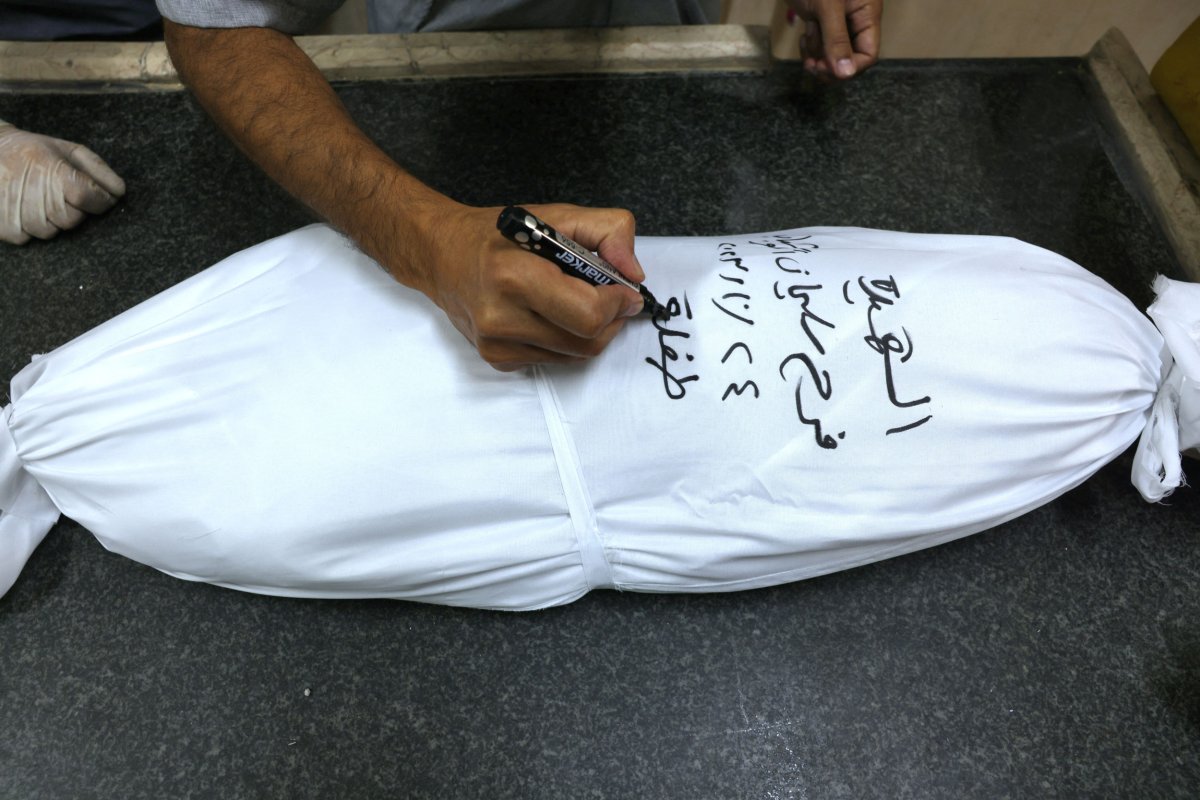
A Palestinian medic writes the name Farah abu Shabab on the wrapped body of a child killed in an Israeli strike, at Najjar hospital in Rafah on the southern Gaza Strip on October 24, 2023, amid the ongoing battles between Israel and the Palestinian group Hamas.
Assuming the 24,500 number is accurate, does it prove that Israel is intentionally killing civilians? And more important, is it an excessive number? Wars of similar intensity might provide some clues, but the differences in size of the battlefield, intensity, and the focus of strikes and even population density make comparisons difficult.
In Ukraine, for example, the intensity of fighting in the east has led to an estimated 300,000-plus soldier deaths on both sides across a 1,500-mile front. The number of civilians killed, according to the U.N.'s "verified" numbers, is around 10,000. Far more civilians have died, but in the largest Ukrainian cities there is no fighting comparable to that in Gaza, and the civilian population has largely fled from the eastern battlefield.
"The population density and the land area make a side-by-side comparison impossible," says the senior defense intelligence officer. By land area, some 1,677 Gaza Strips could fit into Ukraine. "It would be the ultimate irony if, based on Israel's conduct in Gaza, that the Russians are shown to have been more careful," the senior defense intelligence officer says.
In the second Gulf War of 2003, some 3,000 civilians died in Baghdad during the initial stage of the American invasion, but when ground forces reached the capital, the number of casualties ballooned as the internal chaos in the country grew. The United States dropped 29,500 bombs in 22 days during this period, but in Baghdad, few weapons were dropped and those were limited to the "Green Zone" official area where few civilians lived. Other strikes were focused on enormous Iraqi military bases on the outskirts of the city.
"One might say that we focused too much on hitting specific aimpoints and not [enough] on killing Republican Guards," says the military lawyer who was in the command center assessing target selection. "By not trying to decimate the Saddam loyalists, we had to fight them later. In this regard, Israel is perhaps learning from our error."
During Israel's 34-day campaign against Hezbollah in Lebanon in 2006, the IDF flew some 12,000 aerial missions in 34 days, attacking 2,700 targets and dropping some 24,000 weapons from the air. Lebanese authorities estimate that 1,200 civilians were killed. Lebanon's population density is less than one-tenth that of Gaza, meaning that a comparable civilian toll might be about 12,000 deaths, or even 24,000 if one doubles that number to match the number of days. Lebanon is also 29 times larger than Gaza, a factor in considering similar deaths.
"Gaza is a festival of disinformation, exaggeration and self-pity," says the retired IDF general. "When the dust settles, we will see that indeed Israel is not in the wrong in any way."
After two months of fighting, Israel had delivered some 140,000 weapons, 70 percent from artillery rounds and 30 percent weapons dropped from aircraft. U.S. intelligence data show that Israel has attacked about 25,000 targets from the air and ground. Palestinian officials say over 50,000 housing units have been destroyed and another 250,000 have sustained damaged, comprising about 60 percent of Gaza's housing stock. Some 100 government buildings have been completely destroyed, according to U.S. intelligence data.

Hani Abu Jamea, a Palestinian from Khan Yunis, follows his father who is carrying the body of his daughter, Sidal, who died while sleeping in a tent from a shrapnel fragment following Israeli bombardment on a nearby position, in Rafah in the southern Gaza Strip on December 12, 2023.
Given the extent of damage inside Gaza, U.S. military and intelligence officers following the war agree that civilian casualties measured per bomb or per target are exceptionally low. Yet that seems unlikely to make much difference when weighed against the extent of very visible human suffering.
"Israel is conducting its campaign with the justification that it is destroying Hamas when, after two months, it says that it has only killed some 20 percent of pre-war estimates of the number of fighters," the U.S. senior military intelligence officer says. "It is a classic case of winning the battle and losing the war. I'm afraid that despite all of its efforts, this is ipso facto an attack on civilians."
No comments:
Post a Comment